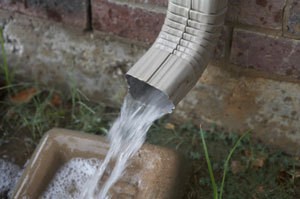
For many homeowners, cleaning out and inspecting gutters and downspouts is an unpleasant, yet unavoidable, chore that has to be done at least once or twice a year (even more if your house sits under a lot of trees). Clogged, overflowing gutters can damage your home's foundation, ruin your lawn and landscape, attract mold, and serve as a breeding ground for insects- including mosquitoes. Cleaning rain gutters year after year can be messy and dangerous, so here are some useful tips to make the job as safe and easy as possible.
It doesn't matter if your rain gutters are made of metal or vinyl, both types are bound to be full of sharp, pointy objects like screws and fasteners, as well as branches and debris. Always wear gloves and eye protection when scooping leaves, bird waste, branches, and sediment from the troughs. If you find caked-on dirt, remove it with a brush, not with your hands.
Every year, hundreds of homeowners are killed from falls while cleaning out their gutters. Thousands more are injured-often seriously. Use a sturdy ladder placed on a firm, level surface. If possible, always have someone steady the ladder from below. If you have to lean your ladder against the gutter to access it, protect it from bending by placing a small piece of wood inside the trough.
Remove loose debris from the gutters by starting on the low end near a drain exit and working up and away from it. Debris is easier to remove when it's damp, and can be dropped on the ground and raked up later or dropped into a plastic bag.
Once you have removed loose debris from the gutters and downspouts, use a powerful spray from the garden hose to force water into each downspout to clear it. Once it's clear, flush each trough out with water and inspect it for proper drainage.
If you find a clog in a downspout, ream it out with a plumber's snake. Feed the snake into the spout while carefully twisting it, until you feel the downspout opening completely. Run water through the downspout to make sure the clog has completely cleared.
Screens can be added to gutters to keep leaves, twigs, and other solid matter out. Some homeowners find this helpful, but keep in mind that the screens still need to be removed or lifted for cleaning so it may turn out to be more trouble and expense than it's worth.
If you decide to add screens, some commercially available screens come equipped with hinges that allow you to access the gutter for cleaning. You can also make your own screens using aluminum chicken wire or a similar small wire mesh cut to size, and attaching them to the gutters with aluminum screws or rivets. If you have copper gutters, use copper anchors only, and choose screening materials made from vinyl or nylon that won't react with and corrode the copper.
If your roof is higher than a single story, or you feel unsure you can clean your gutters and downspouts safely on your own, its best to consider hiring a professional.

About The Author: Ellen Brown is an environmental writer and photographer and the owner of Sustainable Media, an environmental media company that specializes in helping businesses and organizations promote eco-friendly products and services.
Add your voice! Click below to comment. ThriftyFun is powered by your wisdom!
If you can wait until you've had a spell of dry weather, you can use a leaf blower to clean them out quickly. Some leaf blowers even offer the option of a tube that can be attached that goes up with a curve at the end to let you do first floor gutters from the ground.
The leaf blower is definitely the way to go. This is my son's job, and it takes no time at all with the blower.
I agree that gutter cleaning is soooo important. It can keep water out of your back door, basement, etc.
I only have to clean the gutters every 5 years, my trick is simple. Every time we have new neighbours I send them a letter as a reminder of the laws, local and national, concerning the tree planting distances to be respected and maintained. I of course hide this reminder with a light welcome and the hypocritical saying "Good fences make good neighbours" but I also ask them to cut the branches growing above our roof every year during winter and If they have trees like chestnut I remind them that they have to be extra carefull with this type of trees which leaves and wood do not decay. From their answer or absence of answer I know which kind of neighbours they are going to be, respectful ? OK ! Great ! Unrespectful ? Then I know how to handle them. We have 4 horse chestnust trees and our neighbour has five linden they are all planted on the same line and kept at 2,5m hight.
Add your voice! Click below to comment. ThriftyFun is powered by your wisdom!